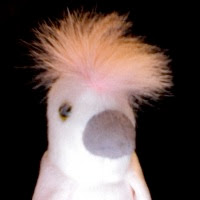Let's go out to our chord garden and gather all the chords we can find! Well, let's start with all the chords we can use in a major key. (We'll take the key of C major as a specific example, but you can translate these chords into any other major key.)
First we pick up the main three major chords. Let's call these the three primary triads of the key. Triad is a name for a three-note chord, basically a major or minor chord.
[one], [four], and [five] — C, F, and G
Then we add the three primary chords from the relative minor key. But these are the three secondary triads in our major key.
[six]m, [two]m, [three]m — Am, Dm, Em
Now we have six chords in our basket. Together these two trios of triads are the six diatonic triads of our major key. Remember that diatonic means these chords are composed entirely of notes that belong to this key.
The rest of our chords will include at least one note that doesn't belong to the key, a chromatic note or non-diatonic note. If you want, you can call these chords chromatic chords or non-diatonic chords.
We're going to borrow the three primary triads from the parallel minor key.
[one]m, four[m], five[m] — Cm, Fm, Gm
But one caution: you'll have to use Cm sparingly, if at all, or this could turn into a song in C minor instead of C major. And no one wants that!
Next we borrow the three secondary triads from the parallel minor key.
[three]♭, [six]♭, [seven]♭ — E♭, A♭, B♭
Look, more major chords to play with! These chords are heavily used in rock, because rock loves major chords but loves to get on the minor side of things. It's a tonal contradiction, one that I would like to blame on The Blues... but that's a story for another day.
That's twelve chords already! Is that enough? Sure, it's enough to write any number of songs with, but there are just three more chords that we can't ignore. It takes some tricky sleight-of-hand to grab these chords. These are the primary triads from the parallel major key of our relative minor key. I know, that sounds so arcane, it's hard to believe that these chords count for anything. And yet many rock songs use them. These chords are:
[six], [two], [three] — A, D, E
Okay, we have fifteen chords in our basket! That's a whole lotta chords to keep track of. But remember, these are all echoes and reflections of our first three chords, [one], [four], and [five]. If it helps, you can think of it as three stars, each of which has several stand-ins and stunt doubles.
Here [one] and its posse:
[one], [six]m, [one]m, [three]♭, [six] — C, Am, Cm, E♭, A
Next, the [four] gang:
[four], [two]m, [four]m, [six]♭, [two] — F, Dm, Fm, A♭, D
And here's the [five] team:
[five], [three]m, [five]m, [seven]♭, [three] — G, Em, Gm, B♭, E
Okay, what if we had gone out into our minor-key chord garden instead?
Actually, we would have ended up with most of the same chords, but in a slightly different order. Only the last three chords would have been something different. We'll be digging for the primary triads of the parallel minor key of our relative major key. These are:
[three]♭m, [six]♭m, [seven]♭m — E♭m, A♭m, B♭m
In minor, the [one] posse:
[one]m, [three]♭, [one], [six]m, [three]♭m — Cm, E♭, C, Am, E♭m
The minor [four] gang:
[four]m, [six]♭, [four], [two]m, [six]♭m — Fm, A♭, F, Dm, A♭m
The minor [five] team:
[five]m, [seven]♭, [five], [three]m, [seven]♭m — Gm, B♭, G, Em, B♭m
Now, what can we do with all of these chords? We'll come back to that question soon.
Sunday, October 18, 2009
Subscribe to:
Post Comments (Atom)


No comments:
Post a Comment